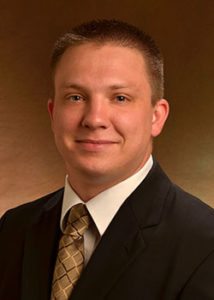
Eric Lukosi
As liquid-fueled molten salt reactors (LF-MSRs) come online, as is expected in the coming decade, then there will need to be an efficient, effective way to measure the radioactive particles that are dissolved in the salt. The current methods for such measurements either involve less accurate on-site techniques or sending a sample off-site for a very expensive lab analysis, including the necessary precautions for transporting radioactive material.
NE Associate Professor Eric Lukosi is researching a way to enable LF-MSR operators to test a sample, press a button, and get the results they need at a cost that is an order of magnitude less than the off-site testing currently available. This research recently received funding from the Department of Energy’s Advanced Research Projects Agency-Energy (ARPA-E) OPEN program for the grant “Microfluidic Alpha Spectrometer for Materials Accountancy and Control in Liquid-Fueled Molten Salt Reactors, ” which was funded for $2,418,576 for a period of three years.
“Generally, the better results you get, the more expensive it is, and if it’s off site, the turnaround time is a lot higher,” said Lukosi. “If it’s on site, the information you gain is lower, but it’s generally cheaper. So there’s a tradeoff, and I’m trying to find the happy medium.”
ARPA-E was implemented to advance high-potential, high-impact energy technologies that are not yet ready for private investment. With this financial boost, Lukosi and his research team aim to develop an alpha spectrometer that can withstand heat and the corrosive environment of an LF-MSR and be used by in-house operators for on-site measurements.
UT Space Institute (UTSI) is also playing an important role on the project. UTSI Research Professor Brian Canfield, of the Center for Laser Applications, will conduct precise ultrafast laser micromachining of the diamond chips that are vital to the spectrometry of the research.
The design will be developed using experimental and computational methods and will be accompanied by a proprietary software program that will enable rapid processing. Having an on-site spectrometry system would not only save operators the time and expense with measuring the fuel composition of the molten salt, but it will also help improve material control and accountancy.
“The reactor operators are going to do what they need to do to operate safely, but they would also like to get a more rapid turnaround on-site that doesn’t require an expert to interpret the results,” he added.
One of the goals with this project is to develop a technology that can guide policy development from the Nuclear Regulatory Commission (NRC).
Ideally, Lukosi hopes to develop a system that can help guide realistic regulations based on what is technologically possible. He envisions it to let the operator sample the salt, whether it’s connected to the reactor or not, and measure the alpha radiation with a higher resolution than is currently available without electrochemical processing.
If Lukosi’s research is successful, Terrestrial Energy USA is one of the target companies to adopt the technology. Lukosi is already working with them to identify the best way to implement the technology, including how to effectively sample the molten salt to use the sensor and how often a measurement would be needed. Further, the design will ensure that it works with their proprietary salt.
Lukosi’s system aims to be less complex, less expensive, and deliver results with the accuracy that can hold up to the rigorous NRC regulations.